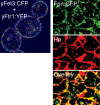Redox cycling in iron uptake, efflux, and trafficking
- PMID: 20522542
- PMCID: PMC2930670
- DOI: 10.1074/jbc.R110.113217
Redox cycling in iron uptake, efflux, and trafficking
Abstract
Aerobic organisms are faced with a dilemma. Environmental iron is found primarily in the relatively inert Fe(III) form, whereas the more metabolically active ferrous form is a strong pro-oxidant. This conundrum is solved by the redox cycling of iron between Fe(III) and Fe(II) at every step in the iron metabolic pathway. As a transition metal ion, iron can be "metabolized" only by this redox cycling, which is catalyzed in aerobes by the coupled activities of ferric iron reductases (ferrireductases) and ferrous iron oxidases (ferroxidases).
Figures



References
-
- Sumner J. B. (1926) J. Biol. Chem. 69, 435–441
-
- Deleted in proof
-
- Deleted in proof
-
- Deleted in proof
-
- Mann T., Keilin D. (1938) Proc. R. Soc. Lond. B Biol. Sci. 126, 303–315
Publication types
MeSH terms
Substances
Grants and funding
LinkOut - more resources
Full Text Sources
Medical
Research Materials

